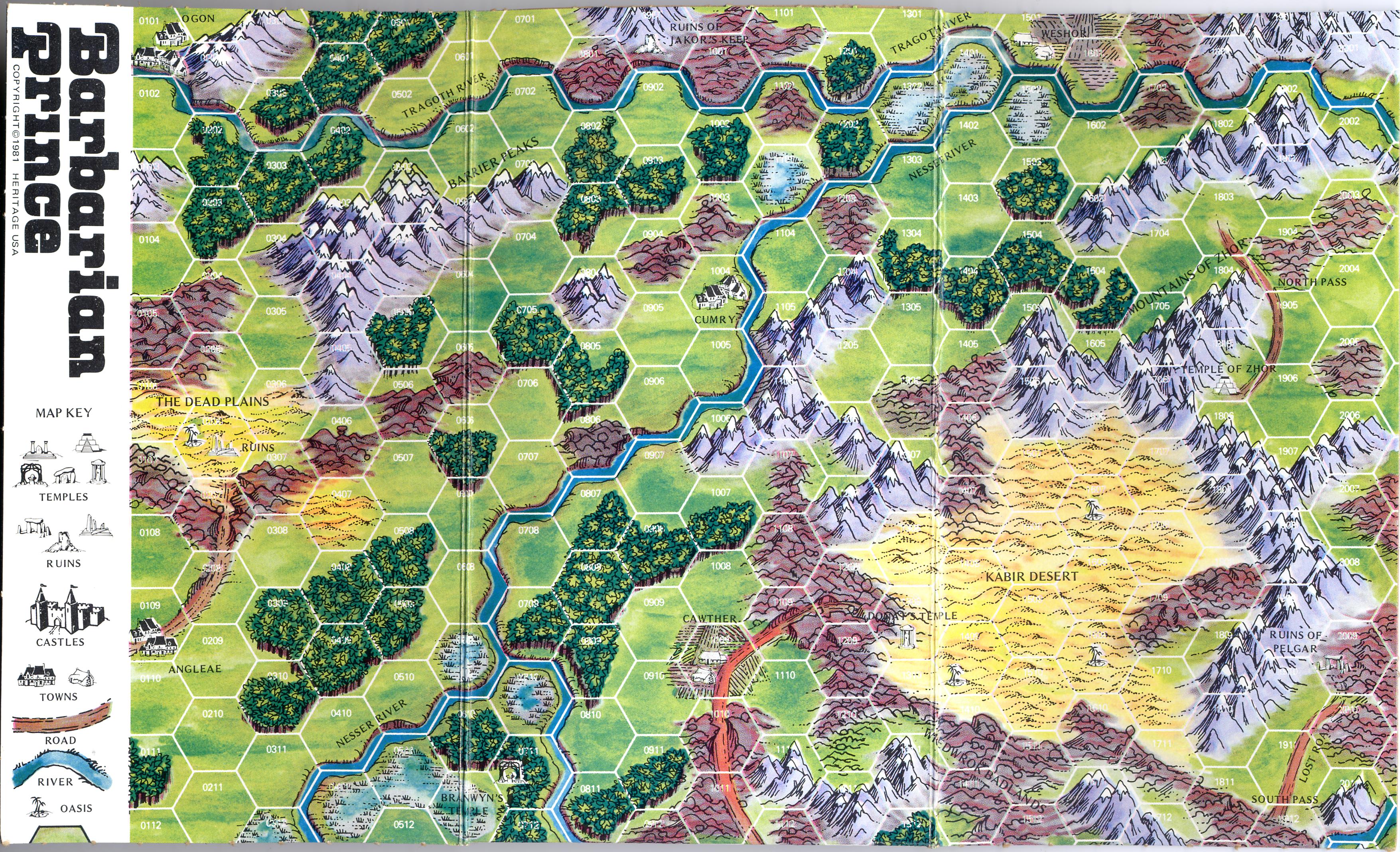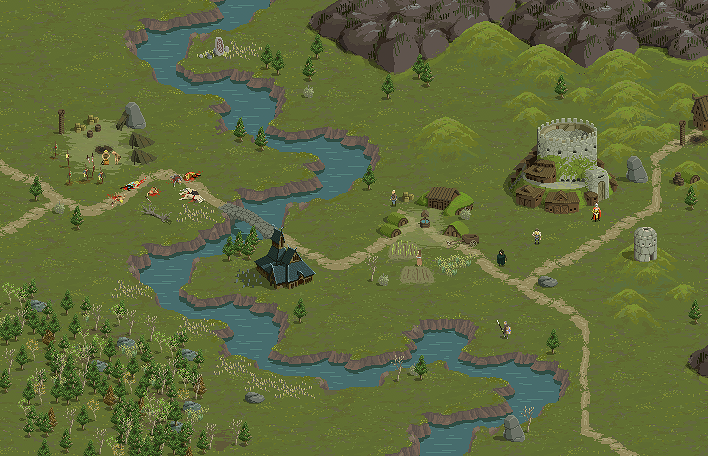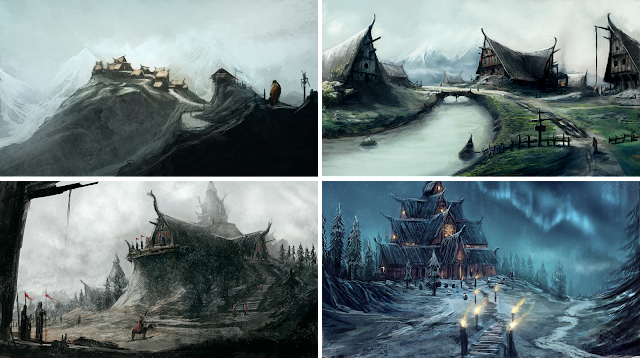Fallen Gods Update #6: Mappa Mundi
 You walk in the gloom of old firs, lost in thought, the world still but for your shuffling steps, the low-growing rowan blown by the breeze, and far-off birds softly purling. When at last you shake loose from this wood-spell, you find the path long gone, and the day’s last span is spent in merely getting back.
Fallen Gods
You walk in the gloom of old firs, lost in thought, the world still but for your shuffling steps, the low-growing rowan blown by the breeze, and far-off birds softly purling. When at last you shake loose from this wood-spell, you find the path long gone, and the day’s last span is spent in merely getting back.
Fallen Gods is a game focused on exploration. While that includes mechanical and narrative layers of exploration, the first and most basic layer is simply walking the land, seeking opportunity and avoiding danger.

The promise of a wonder-filled world to explore is one of the great pleasures of fantasy novels and RPGs. As civilized pleasures go, this one has a long pedigree: medieval maps purporting to depict the real world, such as the
Hereford Mappa Mundi, look much closer to a
Might & Magic map than what we would find in a contemporary atlas. In fact, even modern
tourist maps retain some of this breathless excitement, a kind of simultaneous streamlining and exaggerating of the world to emphasize “points of interest” and tantalize the traveler with the adventure to be found at them.
This “point of interest” concept is, literally, used to describe map features in RPGs and strategy games. As I discussed in the
“Days of Yore” update, one of the key inspirations for
Fallen Gods was the old board game
Barbarian Prince, a single-player board game that used a large, hex-celled map. And you can see such “points of interest” here: the Ruins of Pelgar at the end of the Lost Road beyond the Kabir Desert; Branwyn’s Temple at the crook of the Nesser River; the town of Angleae that sits just south of the pass leading into the Dead Plains. Even a jaded and weary old timer like me still feels a certain tug of wanderlust when looking over that map.

Very early incarnations of
Fallen Gods had a hex map (using some free-for-use tiles) that looked quite a bit like an
uglier version of
Barbarian Prince. But the addition of the wonderful
Daniel Miller to the team meant that we could do better than that. And, as Arnold Hendricks himself discovered when making the jump from his board game to the cRPG
Darklands, pixel art can create a more natural feel to the world: it looks like a land in which you’re adventuring, rather than a map over which you’re moving a token.

But while
Darklands’ pixels furnish an attractive landscape that underscores the game’s well-researched realism, they seemed to lack a certain pizzazz when I first played the game. The reason, I think, is that I had spent formative childhood years playing console RPGs, and
Chrono Trigger’s beautiful world maps had left a lasting impression on me.

So, with
Fallen Gods, the impossible marching orders I gave Dan were to create hex tiles (which are useful for defining the game’s rules for world generation, movement, and the like) that fit together into a seamless pixel art world with distinctive points of interest. I’m pretty sure I used some word as unhelpful as “pizzazz,” perhaps with a wave of a hand. Dan, busy with his bowl of greasy phở (nothing but the best for our artists!), merely shrugged.
And then gave us this:

While this mock-up has a somewhat higher density of “points of interest” than you would see in the actual game, it is nevertheless fairly close to the real thing. In the actual game, points of interest fall into four general categories: (1) dwellings (steadings, towns, strongholds, and shrines); (2) dungeons (caves, marshes, and barrows); (3) locations; and (4) encounters.
Dwellings

When the fallen god reaches a dwelling, the player is given a
menu of options for how to interact with it, similar to
Darklands. The god can rest, buy food, hire followers, gather lore, and, in some instances, resolve crises to his advantage. But each kind of dwelling has its own distinctive characteristics.
Steadings—“villages,” if the word weren’t impermissibly French—are the lowest tier of civilization in
Fallen Gods. They can be found on the plains (most commonly), in woods, or up in the hills. They are a fine place to recruit the lowest tier of follower, churls, who—overawed by the presence of a god and eager to escape a life of drudgery—will follow for free. In woodsteads, you can also find woodsmen (who are good guides and hunters, and whose archery can give you an edge in pre-combat skirmishing), and in hillsteads, where raiding is commonplace, you can find the occasional fighter. The lore steadings offer is mostly local gossip (
i.e., information about nearby points of interest) and the quests tend to revolve around local issues such as feuds, food shortages, wolf problems, and the like. Since all steadings are centered around food gathering (farming, hunting, and grazing), food is usually inexpensive. And since the local headman is a petty leader, the obligatory guest-gift to rest in his hall is relatively light.
Towns, always located on either coasts or riverbanks, are hubs of trade and commerce. Churls still make up most of the population, but there are also mercenary fighters to be hired. Food is more expensive than in steadings (given the greater demand and proportionally smaller supply), as is rest, befitting the greater stature of a town’s thane. The lore tends to be broader—reflecting the wide-roaming nature of the town’s long ships—and the quests are directed seaward, dealing with plagues or visitors from abroad, river monsters or beached whales. A unique aspect of towns is that you can hire a ship to take you to any other town on the map, a quick way to travel in a game where time is the one resource that can’t be regained.
Strongholds are the seats of power for jarls, the highest-ranking leaders in a world where Orm has insisted on keeping his kingship even after becoming a god. Fighters are plentiful, and the god can also hire a skald here. The jarl’s own skald provides a rich source of lore, including not merely about what is going on in the land but about where legendary treasures and foes may be found. Stronghold quests reflect the intriguing that goes on around the powerful, particularly regarding matters of succession.
Shrines are dedicated to the worship of Orm and the Ormfolk, and are thus a welcome haven for the fallen god. The priests who tend the shrine and its holy fire will, for a suitable offering to their principal god Orm, provide magnificent healing services to any who rest within their temple. And if the god has no priest following him, the shrine will gladly provide one, to advise him on the laws of gods and men and to provide healing on the road. As for information, shrines’ loremasters know more than anyone, and thus a god can learn much about lost relics and the like. Finally, quests in shrines tend to be about questions of doctrine, performance of rituals, resolution of schisms, and similar theological issues.
Dungeons

Unlike dwellings, which primarily offer comfort and support, dungeons are interesting as challenges. In essence, they are a stack of event “cards,” with the bottom-most card presenting a significant reward but also a significant challenge, and the upper cards presenting obstacles that wear down the god’s strength and resources. As with dwellings, however, there are distinctions among them.
Barrows—the characteristic above-ground burial mounds of the Norse—are the smallest dungeons, and indeed they are almost always only one “card” deep. There are many barrows on the map. A few contain nothing, a few contain minimal threats and rewards, and a few contain more significant adversaries. In general, barrows naturally feature the dead (draugar in
Fallen Gods’ parlance), though one may also meet cavewights, outlaws, wizards, and wurms.
 Caves
Caves can be of varying depth (from three to seven events down) and are full of subterranean foes: wolves making dens in the upper levels, trolls and trollshards seeking shelter from the sun, and cavewights and dwergs for whom these depths are home. Some dead from times long past may be interred in the depths, and wurms and other ancient evils can likewise be found at the bottom.
There is a single
marsh dungeon on the map, and it is the largest dungeon, befitting the wending swamp paths. The waters are full of the unhallowed dead left behind in the
Overthrow, as well as bogwights and worse. At the heart of a marsh a god may find a rotting Firstborn god, an encampment of dead men still fighting the old wars, a wise witch, or a wurm who thinks himself a king. Thematically, if caves are about the dark unknown and the preservation of the past, swamps are about filth and the decay of the present.
Locations

Locations, as the generic name should suggest, are much more common and much more varied than the points of interest described above. Locations are events that spawn when the world is created and persist until the player triggers them (
i.e., by entering the hex containing the location). In almost all instances, once the event is triggered it no longer persists—the location may still be a visible map feature, but there will no longer be anything to do there.
While the player can see the entire map when the game begins, locations are shown in a way that makes their nature somewhat non-obvious. When the god draws near, the location resolves into a clearer state. For instance, what initially appeared to be large boulders may turn out to be dead trolls. A tall pole may turn out to be the binding place of an outlawed berserk or a scorn pole with a horse’s head atop it.

The map will include many features like boulders or cairns or farm houses that are not location events; as the player draws near, they will not resolve into anything more interesting, and entering the hex will not cause an event to trigger. Thus, while the player may have some guesses about where he can go, he won’t know for sure that a map feature is a location event until he either investigates it, gathers lore about it in a dwelling, or uses the Foresight skill (at the cost of a soul) to scry it out from a distance. Bird fetches (ravens or eagles) have the benefit of expanding the god’s range of investigation, such that he can discern location events from a greater distance than a god with a wolf or fox fetch.
Encounters

Finally, encounters are transient events. They spawn as the god explores the world, appearing at the edge of his range of exploration. If he does not investigate quickly, the encounter disappears for good. An encounter might involve a churl bringing his harvest to market, a songspeaker hastening down the road on his unholy horse, or a pair of outlaws splitting the fruits of a murder. While other points of interest help make the world feel like more than empty space, encounters help bring it to life by suggesting that things happen on their own, and resolve on their own, rather than waiting in abeyance until the god deigns to intervene. Moreover, because they spawn near the god, encounters ensure that there is always something interesting to do, even when doubling back across ground you’ve already covered.

* * *
A great deal of content is necessary in order for these points of interest to work in the context of a game designed for multiple play sessions in different procedurally generated worlds. As explained in prior posts, and as will be discussed in more detail in later posts, events themselves permit considerable replay because there are so many paths through them, and which paths are available depends on the god’s skills, items, followers, fetch, and resources. But equally important in capturing the cartographical thrill when the player first sees the world map is making sure that there is a great variety of events as well: that players will enter new towns, see new map features, and be surprised by new encounters while exploring. This content creation, which entails literally hundreds of events with associated painted illustrations and recorded narration, is probably the single most time-consuming aspect of
Fallen Gods’ development. But, hopefully, it will be worth it in the end.
NEXT UPDATE: Followers





















![Glory to Codexia! [2012] Codex 2012](/forums/smiles/campaign_tags/campaign_slushfund2012.png)
![Have Many Potato [2013] Codex 2013](/forums/smiles/campaign_tags/campaign_potato2013.png)
![The Year of Incline [2014] Codex 2014](/forums/smiles/campaign_tags/campaign_incline2014.png)

























